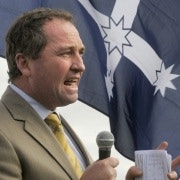Beware high-speed train robbery
For anyone who can add up, the high-speed rail phase 2 study released yesterday (or, if you were a newspaper journalist, Wednesday) should bring to an end the flirtation Australia's polity is having with the idea of a high-speed rail network. There, in black and white, not very far into the report, is the key reason why:
"Based on charging competitive fares, the HSR operations and ancillary services (such as car parking and lease revenues from related property development) would not deliver sufficient revenue to fund or recover the expected capital cost of the HSR program."
That is, if governments spend $114 billion (in 2012 dollars) building the thing, that's the last taxpayers will ever see of that money. It's sunk. Gone. The best a high-speed rail network could do is cover its operating costs, if it prices tickets competitively with airlines.
Like the phase 1 study, the report assumes airlines won't respond to this new competitor on their key routes, but simply reduce capacity, allowing HSR to take up to 40 per cent of air passengers on east-coast routes. However, it does model a scenario in which airlines engage in a two-year price war with HSR, declaring it doesn't substantially change the financial outcome. More damaging is the scenario in which the New South Wales and federal governments get their act together and resolve Sydney's aviation capacity constraints, which increases the losses of the network and reduces the economic benefits of the investment.
Advocates of HSR will doubtless respond that writing off the cost of the investment is acceptable when it comes to roads. Putting aside that we should be charging for road access, at least in metropolitan areas, this misses the signal that failing to cover capital costs sends: this is an investment that isn't needed. We already have a highly competitive, efficient transport network between Brisbane, Melbourne, Sydney and Canberra -- called airlines. There is no market failure for government to address here: indeed, in constructing such infrastructure and then failing to price it to cover its costs, governments will be engaging in a vast exercise in anti-competitive behaviour against private companies that have to generate a return on capital.
In contrast, the much smaller (despite whatever Malcolm Turnbull claims) government investment in the NBN will generate a return because access pricing is intended to cover the cost of capital and yet will still be attractive to service providers. In the case of broadband, there is a market failure (one facilitated by successive governments), and the government's investment will be repaid. High-speed rail is like investing in a new copper network when we already have fibre-to-the-premises.
There is also the issue of cost. Australia is a vast country, with only 23 million people. There are no European or Japanese-style population densities and short distances that normally make HSR viable. We have long distances and few people. The $114 billion price tag is in 2012 dollars, for a project that wouldn't start until the 2020s and take 31 years to build. The final cost, even without the delays typical of major projects, will be in the hundreds of billions of dollars, all of which will need to come directly from the budget, because there will never be a return on it.
And for $114 billion, you could buy airline tickets for everyone who currently flies on the Sydney-Melbourne, Sydney-Brisbane, Melbourne-Brisbane, Sydney-Gold Coast, Melbourne-Gold Coast, Sydney-Canberra, Melbourne-Canberra, Brisbane-Newcastle and Melbourne-Newcastle routes, for free, for more than a quarter of a century.
Probably even longer if you asked for a bulk discount.
Forget $114 billion on HSR. For 5-10 per cent of that, you could make a serious dent on congestion in Melbourne or Sydney, generating a substantial economic return by reducing the $20 billion-plus per annum in congestion costs we'll be facing by 2020. For 1 per cent of that, you could further improve reliability and cut maintenance costs on the east coast rail freight corridor, slowing the growth rate of trucks on inter-city roads and curbing freight-related greenhouse emissions. And that's before you start looking beyond transport for Australia's infrastructure needs.
Labor has fulfilled its election commitment to investigate HSR. It turns out it's not a goer. Let's move on.
This article was first published on Crikey on April 12. Republished with permission.













